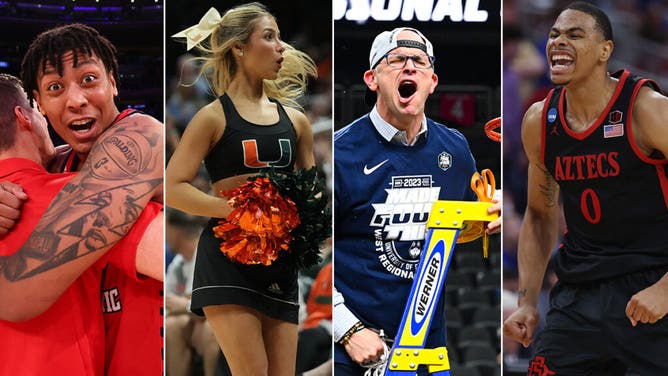Why The NCAA Tournament Is The Most Perfect Postseason In All Of Sports
The NCAA Tournament is 32 games over two days to start on a Thursday and a Friday. Nobody watches all of those, but parts? Yes. Then it’s 16 games over the next Saturday and Sunday, then eight over the next Thursday and Friday and four over the next Saturday and Sunday.
And three games over three nights to close. So linear. So beautiful.
Treat yourself to the final three NCAA Tournament games in Houston through StubHub, the easiest place to buy/sell tickets to all the biggest events.
The third Saturday of the NCAA Tournament is the next one as the Final Four opens on CBS with No. 5 seed San Diego State (31-6) playing No. 9 seed Florida Atlantic (35-3) at 6:09 p.m. No. 4 seed Connecticut (29-8) and No. 5 seed Miami (29-7) follow at approximately at 8:49 p.m.
The championship game will be at 9 p.m. Monday.
The NCAA Tournament is unparalleled in sports viewing pleasure in a span just under three weeks starting with the first Thursday in the field of 64 teams. It is a total of 63 games, excluding the first four play-in appetizers, but it doesn’t seem like that many.
The NCAA Tournament is simply perfect, because it’s perfectly simple. Here’s why:
Brevity Is The Soul Of Drama
Starting with the first Thursday, the NCAA Tournament is 10 game days over just 19 days. Not too short, not too long, with quick breaks in between, so it’s not continuous. It’s just right. The NBA playoffs typically take two months because too many teams are allowed in for too long series. The NCAA Tournament is single elimination. What is more dramatic than do-or-die? It’s better than, “Well, we’ll get them in the next four games.”
Over six weeks or so in the NBA playoffs, much of the drama tends to dissipate gradually until people grow bored waiting for the final series. If one team sweeps, it can wait up to two weeks before it plays again if its opponent’s series goes seven games.

The 2023 Final Four: Florida Atlantic, Miami, UConn and San Diego State. (Getty Images)
The NFL and Major League Baseball playoffs also take about a month, which is not bad. But there is typically a two-week delay between the AFC and NFC title games and the Super Bowl, which creates too much of a lull. Anticipation wanes amid useless stories and radio talk in the interim.
In the NCAA Tournament, there is exactly one day between the national semifinals and final. No lull. No time for excessive coverage or BS. It’s bam, bam in the NCAA Tournament. It’s often hard to catch your breath, which is much better than another yawn.
Brackets
Other sports have brackets, always have. But there is no other sport in which the bracket is its own entity as it is in the NCAA Tournament. And no other postseason setup spawned a new word from the bracket root – bracketology. There are whole shows devoted to these line-by-line discussions.
There’s an NFL playoff bracket, but no one talks about it like it’s the Ark of the Covenant, which it is in the NCAA Tournament. Millions of NFL, NBA and MLB fans do not carry their bracket around with them for three weeks and discuss it incessantly.
The brackets also have a gambling edge. If someone gets their bracket exactly right from game one through 63, they can win enough money to buy their own mid-major program. But the odds are astronomical, so the bracket thing brings in the lottery aspect to the NCAA Tournament. Like it needed more excitement.
Seeds
Seeds have been around about as long as there have been tournaments. There was actually a 12-5 upset in the pankration event in the first Olympics in Greece in 776, but it went largely uncovered. No seed goes uncovered in the NCAA Tournament.
The NCAA Tournament only started seeding teams in 1979, and they continue to hatch like crazy every March, like in no other postseason affair. Fans know the seed of a school (16 Fairleigh Dickingson) before they know where the school is (somewhere in New Jersey).

Cameron Tweedy of the Fairleigh Dickinson Knights. (Getty Images)
The seeds are the thing. They are the cornerstone of what sets the NCAA Tournament apart – the upset.
Seed histories are tracked like hurricanes for the NCAA Tournament. For example, this will be the first Final Four ever without a No. 1, No. 2 or No. 3 seed. If No. 9 seed Florida Atlantic wins it all, it will be the worst seed ever to win the title. The previous was No. 8 Villanova in 1985 over No. 1 Georgetown.
The NFL several years ago copied the NCAA Tournament. It started calling the playoffs “the tournament.” Cute. It hasn’t worked. Quick, what’s the biggest seed upset in the NFL playoffs history? No one cares.
Upsets, Better Games
Theree have been 52 upsets of No. 5 seeds by 12 seeds in the NCAA Tournament. Who looks that up? It’s amazing. That’s a winning percentage of 35 percent. That’s what keeps people coming back to the NCAA Tournament. They want the upset, and they happen every year.
This year alone, the NCAA Tournament gave you the second-ever No. 16 seed upset of a No. 1 when Fairleigh Dickinson beat Purdue. And we got a No. 15 seed, Princeton, beating No. 2 seed Arizona, and No. 3 Furman, knocking off No. 4 Virginia all in the first weekend. But this happens all the time – before the transfer portal and after the transfer portal.
The NCAA Tournament has its blowouts like all postseasons, but they go virtually unnoticed because of the plethora of upsets. The other playoffs are so drawn out for longer periods of time with fewer games that one can’t get away from blowouts.
College basketball is also a quicker game. Two hours. Bank on it. An NBA game is usually two-and-a-half hours. You can watch two NCAA Tournament games in the time it takes to watch an NFL or MLB game. If it’s a blowout, most of the time you can find another game easier in the NCAA Tournament. In other sports, you tend to be stuck with it.
Natural Parity, But Not Too Much
“It might be parity is here to stay,” CBS’ Grant Hill said after the last of the eight top seeds (4 No. 1s and 4 No. 2s) fell on Sunday when No. 5 Miami beat No. 2 Texas. That made for the first Final Four without better than a 4 seed, and it put three-first timers in – Miami, San Diego State and Florida Atlantic.
Well, the portal was in full force last year, and the Final Four featured four blue bloods – North Carolina, Duke, Villanova and Kansas, which won it all.
SHALL WE DANCE? NORTH CAROLINA AND DUKE FOR THE FIRST TIME
Cinderella in the Final Four is not new. In 1986, No. 11 seed LSU made it, and No. 6 seed Providence got there in 1987 for the first time since 1973. In 1996, 5 seed Mississippi State went for the first time. From 2006 through 2021, non-blue bloods stormed the Final Four – 11 seed George Mason in 2006, Butler in 2010 and ’11, 11 seed VCU in 2011, 9 Wichita State in 2013, Gonzaga in 2017 and ’21 and 11 Loyola-Chicago in 2018. All without the portal.
So calm down, Grant, there could be four blue bloods back next year. And more Cinderellas the next. The parity happens naturally, and not too much. It’s a golden mean.
Few Format Changes
You can depend on the NCAA Tournament to happen like it almost always has. The NCAA went to 64 teams in 1985, and refreshingly, little has changed. The tournament went to 65 in 2001 with a play-in. Then it went to four play-ins in 2011 on the Tuesday and Wednesday after the Sunday Selection Show.
The real NCAA Tournament still starts on that Thursday with 64. It’s a great thing, don’t mess it up.
That is one thing the NCAA has got right. You can’t mess with perfection.
Get your Final Four tickets at StubHub, the easiest place to buy/sell tickets to all the biggest events.